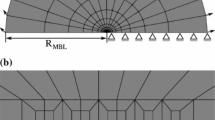Abstract
For a compression-shear mixed mode interface crack, it is difficult to solve the stress and strain fields considering the material viscosity, the crack-tip singularity, the frictional effect, and the mixed loading level. In this paper, a mechanical model of the dynamic propagation interface crack for the compression-shear mixed mode is proposed using an elastic-viscoplastic constitutive model. The governing equations of propagation crack interface at the crack-tip are given. The numerical analysis is performed for the interface crack of the compression-shear mixed mode by introducing a displacement function and some boundary conditions. The distributed regularities of stress field of the interface crack-tip are discussed with several special parameters. The final results show that the viscosity effect and the frictional contact effect on the crack surface and the mixed-load parameter are important factors in studying the mixed mode interface cracktip fields. These fields are controlled by the viscosity coefficient, the Mach number, and the singularity exponent.
Similar content being viewed by others
References
Williams, M. L. The stresses around a fault or crack in dissimilar media. Bulletin of the Seismological Society of America, 49(2), 199–204 (1959)
Ricci, V., Shukla, A., and Chalivendra, V. B. Subsonic interfacial fracture using strain gages in isotropic-orthotropic biomaterial. Theoretical and Applied Fracture Mechanics, 39(3), 143–161 (2003)
Xia, L. and Wang, T. C. Asymptotic fields for interface crack in elastic-plastic materials. Acta Mechanica Solida Sinica, 13(3), 191–200 (1992)
Dai, Y. and Ji, X. Analyses of stress singularity at interface end and interfacial stress distribution. Science China (Series G), 37(4), 535–543 (2007)
Cheng, Z. Q. and Zhong, Z. Fracture analysis of a functionally graded strip sandwiched between two homogeneous materials. Science China (Series G), 36(5), 530–542 (2006)
Li, X. M. and Lei, Z. K. Digital photoelasticity analysis of stress singularity of bimaterial joints. Engineering Mechanics, 28(12), 7–12 (2011)
Shang, F. L. and Kitamura, T. Molecular dynamics simulations of interfacial crack nucleation and propagation. Chinese Journal of Theoretical and Applied Mechanics, 39(4), 571–576 (2007)
Wang, B. L., Han, J. C., and Du, S. Y. Cracks problem for non-homogeneous composite material subjected to dynamic loading. International Journal of Solids and Structures, 37(9), 1251–1274 (2000)
Viggo, T. Resistance curves for mixed mode interface crack growth between dissimilar elasticplastic solids. Journal of the Mechanics and Physics of Solids, 49(11), 2689–2703 (2001)
Lü, N. C., Yang, D. N., Cheng, Y. H., and Cheng, J. Asymmetrical dynamic propagation problems on mode III interface crack. Applied Mathematics and Mechanics (English Edition), 28(4), 501–510 (2007) DOI 10.1007/s10483-007-0411-x
Yang, W. Y., Zhang, S. Q., Li, J. L., and Ma, Y. L. Interface crack problems for mode II of double dissimilar orthotropic composite materials. Applied Mathematics and Mechanics (English Edition), 30(5), 585–594 (2009) DOI 10.1007/s10483-009-0505-z
Sun, S. Y. and Chen, H. R. Quasi-static and dynamic fracture behavior of composite sandwich beams with a viscoelastic interface crack. Composites Science and Technology, 70(6), 1011–1016 (2010)
Liang, W. Y., Wang, Z. Q., and Yang, Z. J. Steady-state growing crack-tip field characteristics of mode III elastic-viscoplastic/rigid interface cracks. Applied Mathematics and Mechanics (English Edition), 31(2), 227–235 (2010) DOI 10.1007/s10483-010-0210-9
Wei, P. J., Wu, Y. L., and Zhang, S. Y. The shock response of interface crack between dissimilar viscoelastic bodies. Acta Mechanica Sinica, 33(1), 109–114 (2001)
Liu, Y. W., Xie, C., Deng, M., Fang, Q. H., and Jin, B. Screw dislocations and an interfacial blunt crack with viscoelastic interface. Theoretical and Applied Fracture Mechanics, 52(3), 146–153 (2009)
Li, Y. D., Zhang, N., and Tang, L. Q. Researches on the enhancement of fracture toughness induced by friction between crack faces. Acta Mechanica Sinica, 37(3), 280–286 (2005)
Tang, L. H. and Xu, J. Q. Viscoelastic fields near interface crack tip. Chinese Quarterly of Mechanics, 28(1), 116–123 (2007)
Liang, W. Y., Wang, Z. Q., and Zhou, B. The elastic-viscoplastic field at the mixed-mode steadily propagating crack-tip under compression and shear. Chinese Journal of Theoretical and Applied Mechanics, 38(5), 618–625 (2009)
Viggo, T. and Brian, N. L. Effect of anisotropic plasticity on mixed mode interface crack growth. Engineering Fracture Mechanics, 74(16), 2603–2614 (2007)
Shih, C. F. Small-scale yielding analysis of mixed mode plane-strain crack problems. ASTM STP, 560, 187–210 (1974)
Ye, Z. M. Plastic zone characteristics of crack tip in anisotropic solids. International Journal of Fracture, 74(1), R3–R10 (1995)
Author information
Authors and Affiliations
Corresponding author
Additional information
Project supported by the National Natural Science Foundation of China (No. 11302054) and the Fundamental Research Funds for the Central Universities (No.HEUCF130216)
Rights and permissions
About this article
Cite this article
Liang, Wy., Wang, Zq., Liu, F. et al. Elastic-viscoplastic field at mixed-mode interface crack-tip under compression and shear. Appl. Math. Mech.-Engl. Ed. 35, 887–896 (2014). https://doi.org/10.1007/s10483-014-1838-9
Received:
Revised:
Published:
Issue Date:
DOI: https://doi.org/10.1007/s10483-014-1838-9
Key words
- compression-shear mixed mode interface crack
- dynamic propagation
- viscosity effect
- elastic-viscoplastic material
- friction effect
- mixed-load parameter



